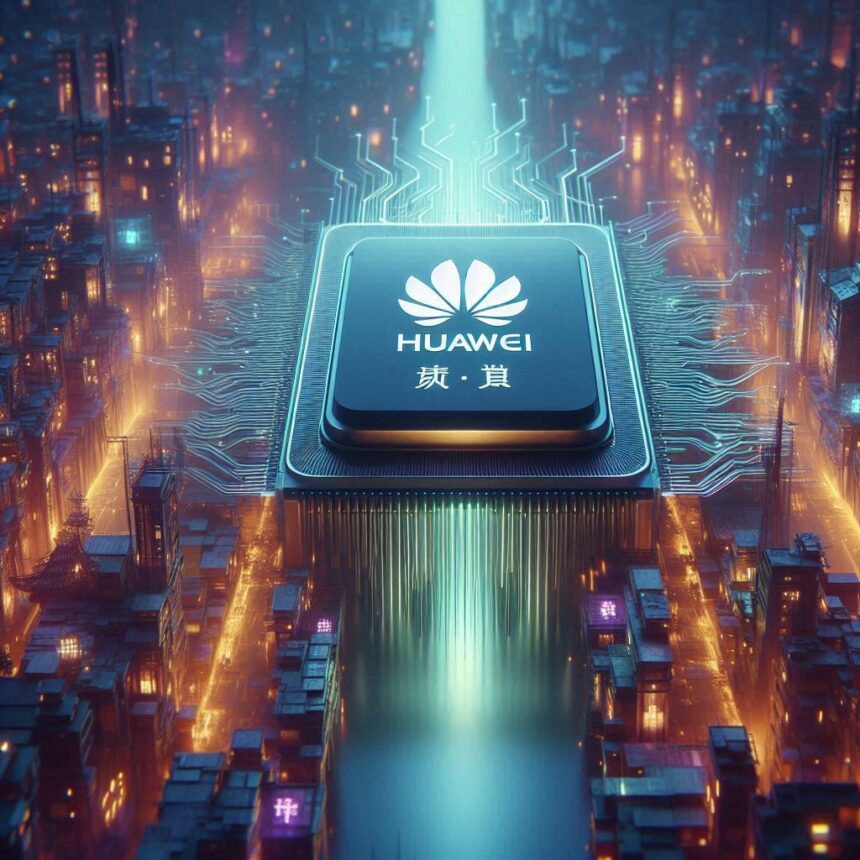Huawei, China’s telecommunications and tech powerhouse, has once again thrust itself into the spotlight with the launch of a new AI chip designed to rival Nvidia’s market-leading GPU offerings. This development comes amid escalating technological rivalry between the United States and China, and signals Beijing’s broader ambition to achieve semiconductor and AI self-sufficiency despite mounting trade restrictions.
With the unveiling of this new processor, Huawei is taking a bold leap to reduce China’s dependence on U.S.-controlled semiconductor technology, targeting one of the most critical components in the AI development stack: the chip.
Huawei’s Strategic Push: The New AI Chip
The chip, internally referred to as part of Huawei’s Ascend AI chipset family, is engineered to deliver high performance in model training and inference, the twin pillars of artificial intelligence operations. Industry insiders suggest that the chip is positioned to compete directly with Nvidia’s H100 and A100 GPUs, both of which have become standard tools for training advanced models like GPT, DALL·E, and Gemini.
Key Features of the Huawei New AI Chip:
- 7nm fabrication (via China’s SMIC despite U.S. pressure)
- High-performance tensor processing units (TPUs) optimized for large-scale matrix operations
- Compatibility with Huawei’s MindSpore AI framework
- Focus on both training and inference workloads
- AI energy-efficiency optimization tools to ensure sustainability
Huawei’s chip aims to cater to sectors such as:
- Large-scale enterprise AI applications
- Government-backed smart infrastructure projects
- Autonomous driving technologies
- AI-enhanced telecommunications
Context: Trade Restrictions and Technological Decoupling
The unveiling of this chip comes in the shadow of ongoing U.S.-China tensions over technology exports, particularly in the semiconductor sector. The Biden administration has imposed stringent export controls on advanced AI chips developed by companies like Nvidia and AMD, effectively barring them from being sold to Chinese firms.
In response, China has doubled down on its goal of achieving “chip independence“, pouring billions into domestic semiconductor R&D and manufacturing capabilities.
Huawei’s Dual Challenge:
- Overcome technical barriers imposed by sanctions
- Compete with Nvidia, the undisputed leader in AI silicon
Technical Overview and Performance Benchmarks
While independent performance benchmarking is still pending, Huawei’s internal tests suggest the new chip offers 70-80% of the performance of Nvidia’s A100 GPU, at a lower power draw and with native support for China-based cloud infrastructures.
The chip integrates tightly with Huawei’s Ascend C and Atlas server families and is expected to become the standard in several government AI projects.
Technical Highlights:
- Memory Bandwidth: Comparable to A100, up to 1.6TB/s
- Computational Throughput: Estimated 240 TFLOPs in FP16 precision
- Fabrication Node: 7nm (challenging yet feasible with local fabrication partners)
- Software Ecosystem: MindSpore 2.0, Python compatibility, ONNX model support
MindSpore: Huawei’s AI Framework
Complementing the chip is MindSpore, Huawei’s answer to TensorFlow and PyTorch. The new AI chip is designed to fully leverage MindSpore’s architecture, offering seamless model development, training, and deployment.
MindSpore provides:
- Optimized graph execution
- Native Chinese language processing capabilities
- Model compression and quantization support
- Enterprise-focused API toolkits
Huawei’s vertically integrated approach—from chip to software to data center—enables them to push out a complete AI hardware-software solution that doesn’t rely on U.S.-based technology.
Huawei vs. Nvidia: A Comparative Look
| Feature | Huawei New AI Chip | Nvidia A100 |
|---|---|---|
| Process Node | 7nm (SMIC) | 7nm (TSMC) |
| AI Throughput | ~240 TFLOPs FP16 | 312 TFLOPs FP16 |
| Memory Bandwidth | ~1.6TB/s | 1.6TB/s |
| Software Ecosystem | MindSpore | CUDA, PyTorch, TensorFlow |
| Market Focus | China-first, enterprise & gov | Global, all sectors |
| Export Restrictions | Not subject to U.S. control | U.S. export restrictions apply |
Strategic Implications for China and the Global AI Race
This development underscores China’s intent to insulate its technological ambitions from U.S. influence. With access to Nvidia’s high-end GPUs restricted, the Huawei New AI Chip is a national strategic asset, potentially underpinning China’s plans for:
- AI-powered surveillance systems
- Military-grade simulation and modeling
- Next-gen industrial automation
It also aligns with the Chinese government’s 2025 technology roadmap, which includes a target to produce 70% of its semiconductors domestically by 2025.
Industry Reception and Challenges
Initial reactions within the Chinese tech ecosystem have been enthusiastic, particularly among firms building models tailored for Mandarin-language NLP, local fintech applications, and domestic healthcare AI platforms.
However, Huawei still faces key hurdles:
- Scaling production capacity without access to ASML’s EUV lithography machines
- Global trust and market access outside of China
- Lack of global developer adoption compared to CUDA ecosystem
What’s Next for Huawei’s AI Ambitions?
Huawei has signaled plans to:
- Release a scaled-down version of the chip for edge AI deployments
- Launch cloud services powered entirely by Huawei AI chips
- Explore international partnerships in non-restricted markets like Africa, the Middle East, and Southeast Asia
Their strategy hinges on domestic adoption first, followed by expansion into non-Western markets.
Conclusion: The Rise of the Huawei New AI Chip
The Huawei New AI Chip is a powerful testament to China’s resilience and determination to lead in the next wave of artificial intelligence innovation. While the chip may not yet dethrone Nvidia globally, it provides a critical foundation for China’s AI ambitions and highlights a future where AI hardware is no longer monopolized by Western tech giants.
As Huawei continues to innovate under pressure, the global AI chip landscape is entering a new, multipolar era—one that will redefine not just how AI is built, but who controls its destiny.
